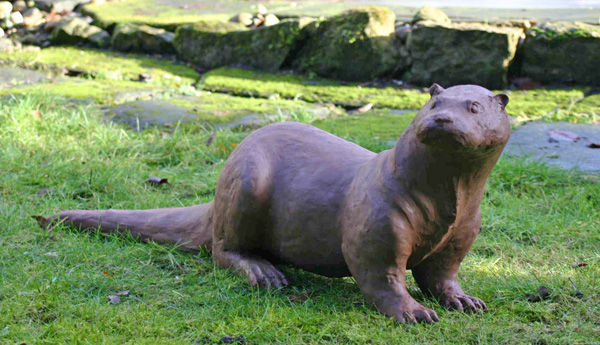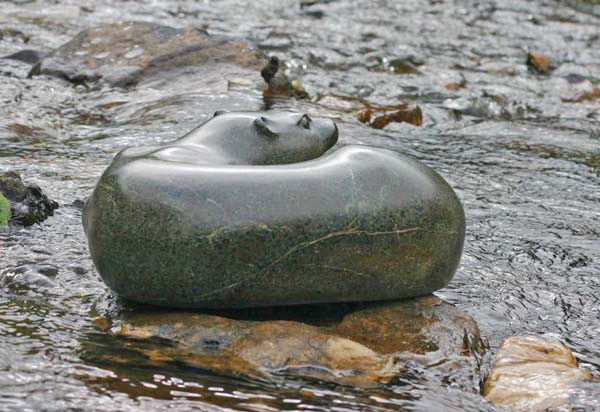Otters

I’m still reading Otter Country by Miriam Darlington – and loving it! Early in the book she writes that after reading Henry Williamson’s Tarka the Otter she was so enthralled and spell-bound by otters, that ‘for months afterwards I felt like I was an otter’.
It was so exciting to read this, as it is exactly how I felt when immersing myself in all things otter when I was carving a sculpture of one. I read about otters, studied their behaviour and dreamed of them. Initially I made many sketches, to try and get to know their shape and character – to get a feel of what was important to capture in my carving.
For many years I wanted to sculpt an otter. Whilst on holiday in Skye I visited an exhibition by the sculptor Laurence Broderick (it was in the very early days of my affair with stone) and watched him working on a turtle in serpentine. There were otter sculptures too. I was in awe – they were so very beautiful. I feared I might not ever make an otter so well, and aspired to his skill. It would be a full six years before I created my own otter.

I made a series of maquettes in clay, before committing to my otter in stone
So, when finally I had chosen my stone – it was a lump of Polyphant (Cornish Soapstone), which I felt perfect for the sheen of wet otter fur – I was alone in my workshop, chisel in hand and brimming with feelings of otter.
I turned into one. Over the weeks of carving, I felt myself to be an otter, moving around in an otter-like way, being aware of whiskers, adopting poses, attempting the alertness. I felt as if I could swim, twist, turn and dart in the water, exerting otter muscles in chase of prey. I smelled otter. And breathed as one.

I remember taking this photograph – I felt my otter should be in water, so I waded out to a stone mid-stream, the water came over the top of my wellies and as I crouched to take the picture I sat in the water too – and felt most unlike an otter!

5 Comments
she is beautiful.
I can’t stop looking at the carved form of this Cornish soapstone; it is so full of the spirit of otter curled there in the water. I have noticed that wild otters take on the sheen of water (I once caught it on film (very very inexpertly) and my husband put it on youtube, but the moment’s gone in a flash). The water camouflages the otters’ sheeny wet pelt momentarily as they reflect the light and water around them, but you have achieved this and captured it in your sculpture!
All power to your inspiration for 2014
Miriam Darlington (author of ‘Otter Country’)
Thankyou so much Ellen!
And Miriam – I am thrilled that you should write this, and feel very proud, it is special coming from you with your knowledge of otters. Otters seem to make the water appear thick on their coates, as if treacle, and as you say, it is momentary and elusive. I will search for your film. This soapstone is a beautiful stone, very tactile, and this particular lump had beautiful veining in too, and mottled colouring that gave the piece a primeval air. I was delighted to read in your book about how far back we can trace the otter. What magic they make!
A beautiful piece – sculpture and story – that reminded me of when you told me about the fish stones you placed in the Tweed; this otter looks as if it could just slip into the water and find them.
Thankyou Sal – what a chase they’d have – stone otter and stone fishes – alive in the Tweed! I wonder if the fishes have actually been nudged by an otter nose? Lovely thought.